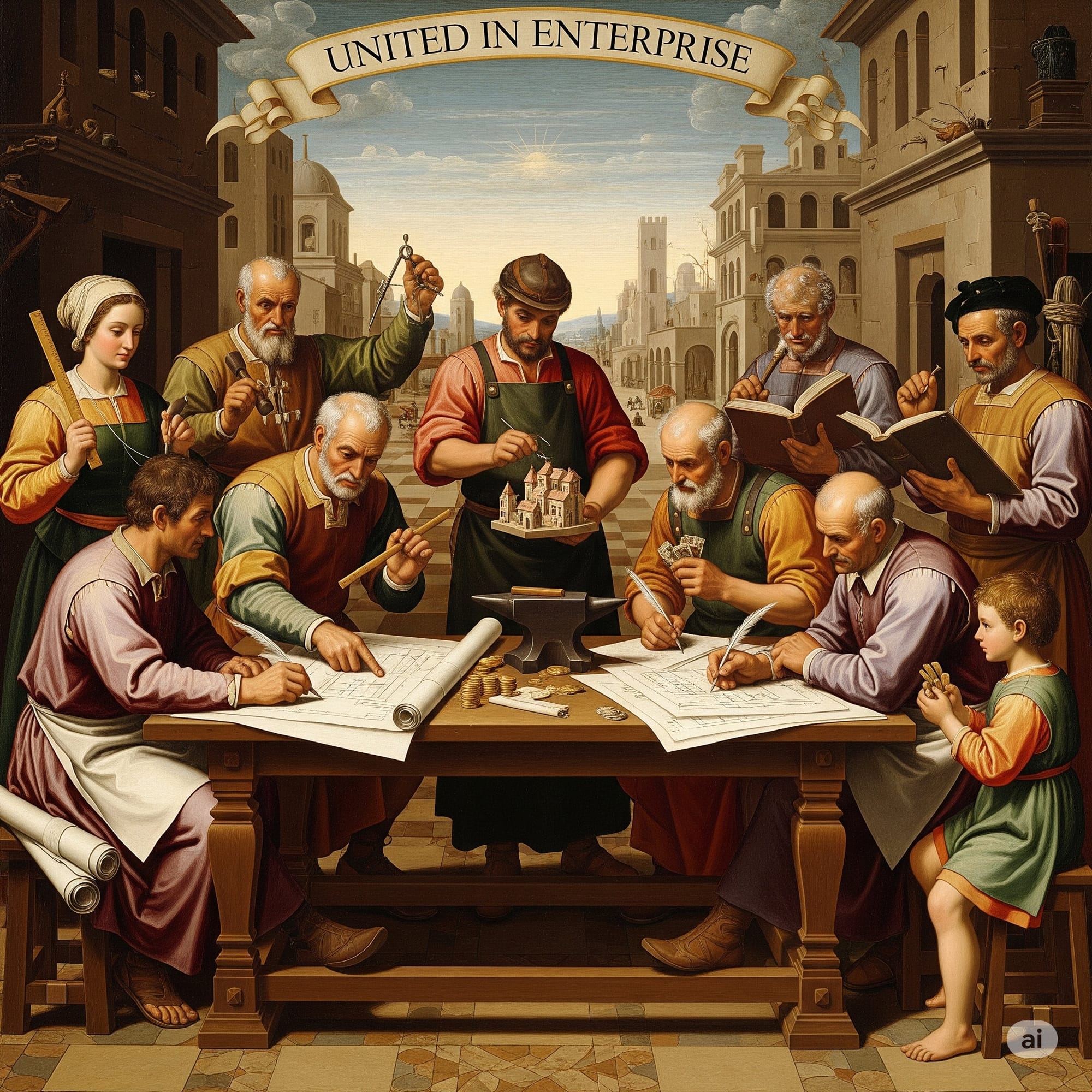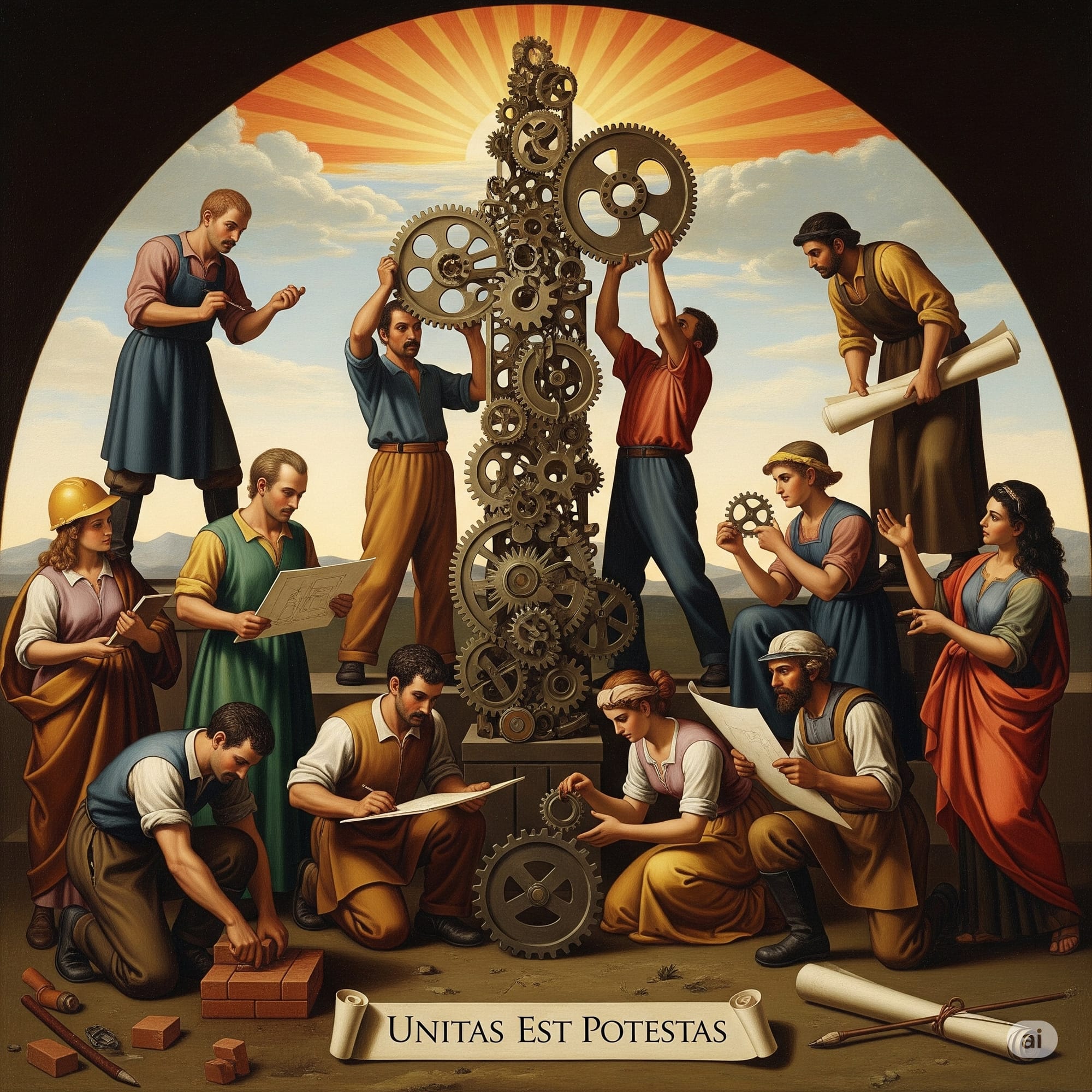TenTogether Story
Heath Arensen, founder of TenTogether



The world is shifting, we can all feel it. From politics, to technology, to culture, to planetary boundaries. Should we be afraid, hopeful, or both? I choose hope. What we do know is that much will change.
TenTogether is a vision for what a new future system, one with people at the center, might look like. It is a piece in the puzzle of a much larger emergence. It is one part experimental, but at the same time confident in the path.
TenTogether is built on the belief that human’s at their core were designed to create, to bring new things into the world. When you ask someone if they have a dream, you will usually see a spark of energetic excitement. Most of us of us have a dream. And this dream, this inner push to create something, tends to be unique to each person. But how many people ever get to truly bring their creation into the world? The barriers of time, money, and most importantly - belief that it can be done - keep these dreams just dreams.
TenTogether’s aim is to bring more ideas into the world. These ideas start within a person, almost like they have emerged from a source deep within and sometimes seemingly from beyond. What would happen if more of these ideas came into the world? Because each holds a uniqueness, while being similar to others, there becomes a web of interconnected and organically decentralized coordination between them.
When individuals are resourced to bring their ideas to life, and then remain in connection through purposeful community and organized integration with the creation of others, a new system organically emerges, this is TenTogether. Simply, it is the resourcing of individuals to bring their creations to life, the systems of coordination between what emerges, and a community building and owning together.
TenTogether is a vision for a future of human organizing that borrows from the past but looks to the future. It reimagines how we design the systems and technologies to build, share, and maintain collective value.
TenTogether is reminiscent of our earliest structure of cooperation, the village. It is a community of purpose working with shared values towards a common future. An infinitely connectable world and a focus on the individual within it has eroded the value of smaller cooperative communities. The village as it was is gone and with it . But through the use of new technologies and intentional system design, the value of the village can return.
TenTogether is a model for building new villages. This is the inspiration for name, ten together rather than one alone. It is the organizing more things collectively rather than as individuals. It doesn’t have to be ten, but it is more than one. There are things in life that belong to an individual, others to groups, and some for everyone. TenTogether will unlock creation, scaling, and maintaining through shifting some things most commonly done as individual, together.
It will start as a community, building common understanding and encouraging the collective to create. As the community grows, we imagine a fund to resource creation and to facilitate the shift in wealth from individuals to community at scale. We imagine technology developed in the open, free for all to use and improve. We imagine innovation in governance and system design that recognizes and accounts for the dynamics of the individual, small groups, those who build, and those who benefit from what is built.
Togetherness inspires me. When living in Kenya, I used to volunteer weekly at an orphanage. Our activity would usually just be to bring a ball and play football. Most of the children were barefoot, adeptly navigating the thorny and rocky soil. There was a day when one of the young boys received a gift from a relative, a pair of shoes. What I saw next would impact me in ways I still don’t have words for. He took one shoe and put it on. He then took the other shoe and gave it to his friend. With smiles they ran onto the soccer pitch, with one foot bare, the other protected. They still had one foot exposed to pain, but there was joy in the sharing. There was not a thought of ownership, no this is mine. Just, this is ours.
Can we think about ownership differently? Can we think of wealth differently? Can we shift from mine to ours?
This is the village. The village is community. The village recognizes that we are not individuals floating through life disconnected and alone but that at our core we are designed for connection. Designed to create, to know, to give, to respect, to love. The village has people, but it is not only people. The village is rooted and sustained by nature. The forest, the fields, the river. A village is an organizing system for life.
TenTogether is based on a set of design principles for the stewardship of community assets, the shared resources a village must collectively maintain. These principles can be used to design the systems of governance, financing, and participation required to manage the creation, and sustaining, of collective community value.
TenTogether challenges current systems, looking them in the eyes and saying, we can do better. We need a vision of markets that sees creation and wealth not as controlled primarily by individuals but more by the custodianship of communities.
Technology, as demonstrated by a number of emergent Web3 models for web governance, platform technologies and AI for increasingly accessible supporting tech and content, can enable a shift to increasing community rather than individual avenues for economic participation. This shift to the village can increase equal access to resources while leading to more sustainable economic systems.
Here are the system design principles of TenTogether:
1. Store wealth in what is shared
Wealth takes the form of assets or money. When wealth is too concentrated with individuals, preservation and growth may become misaligned with the regenerative health of a society. Communities rely on shared natural and created resources. The more we can steward wealth collectively in the form of public goods, the more efficiently the free market can allocate resources.
2. Shift from units of 1 to units of 10.
In many transactional contexts, collateral and trust are a prerequisite. By shifting this from an individual to a group, risk can be diversified and greater access to resources achieved. Why 10? It is an optimal group size for collaboration with a diversity of voices but still small enough for all to be fully engaged. (it doesn't actually have to be exactly 10, just close)
3. There is hierarchy in what is created.
Communities gather around a vision to create. These ideas form projects and flow first from an individual. The vision is sustained by this individual and as a community forms to achieve it collectively, the individual must continue to own the vision.
4. There are natural limits to growth.
Take a cue from nature. A tree will grow quickly once planted, reaches a natural height then stops. There are optimal sizes of communities, rates of growth, regeneration of resources. These must be considered in system design. Exponential in place of regenerative growth is rarely sustainable.
5. The future is decentralized, the present is not
While we see a future where decentralized communities self organize around collective ambition, current institutions like banks, governments, and employers are not. Transitional structures can be designed to act as bridges and play a custodial role on behalf of the community when transacting with traditional organizations.
6. Contribution is the foundation of participation
Giving to a community can take many forms but contribution in the form of time, skills, or resources are required to maintain community assets. A well designed system for recognizing and incentivizing contributions should be viewed less as monetary compensation and more as voting influence.
7. Governance matters
In a designed system, governance sets the expectations for participants, defines how decisions are made, and protects the community. It must be well designed and have the necessary levers for enforcement.
So how do we do this, first, we map it out:
Using the Ten Together principles, we sketch out the design for a particular type of community endeavor. We start by looking at the individual, then the group. The size of a group is so important that it is in the name, Ten Together. By organizing in units of 10 and connecting them through a community of communities model, human connection can be maintained at an ideal size.
Here is an example of how this can work. An individual wants to buy a house but has neither collateral for a down payment nor access to a housing loan. Move it to a group of 10, each with the same challenge. Through pooling resources and sharing risk, the group qualifies for financing. The system design uses enforceable community governance to manage the group repayment of the loan.
However, a system like this won’t work if financial institutions are not willing to create financial products for them. This is step two. Financial instruments must be designed to allow the investment in Ten Together communities.
By organizing communities of communities, sufficient scale and diversification can be achieved to justify financial investments in these communities.
Lastly, this system design provides the basis of a technology platform. Through the use of tokenization, blockchain smart contracts, and collaboration features, the technology becomes a gathering place for the community allowing for effective governance and scale.
As tokens are an efficient and transparent tool for community governance, what is the role of cryptocurrency and decentralized finance in Ten Together system design? It can play a role but it is not the store of value. The goal of Ten Together is to apply resources to community projects and the assets of these projects have an intrinsic value. The tradability of tokens outside of a specific community can be destabilizing so in most cases should not be incorporated in the design.
The governance, system design, financial flows, and technology all work together to allow communities to build and maintain things that matter.
We imagine TenTogether communities everywhere. We see open source communities organizing to maintain their projects, independent gyms operating as co-ops, decentralized manufacturing by independent artisans, community owned housing, farmer directed crop off-takers, and carbon offset initiatives in communities threatened by deforestation.
Each with a TenTogether system design, financial instrument, and technology.
While this system is managed down to a grass roots individual task level, it only works at scale.
Therefore, we are designing for scale.
Ten Together is not proposing anything new. It borrows heavily from microfinance groups, cooperative societies, and collectives. In fact, it is modeled on humanity's oldest settled organizing structure, the village.
